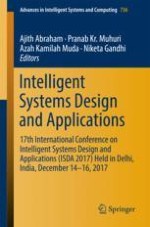2018 | Buch
Intelligent Systems Design and Applications
17th International Conference on Intelligent Systems Design and Applications (ISDA 2017) held in Delhi, India, December 14-16, 2017
herausgegeben von: Prof. Dr. Ajith Abraham, Pranab Kr. Muhuri, Dr. Azah Kamilah Muda, Dr. Niketa Gandhi
Verlag: Springer International Publishing
Buchreihe : Advances in Intelligent Systems and Computing
